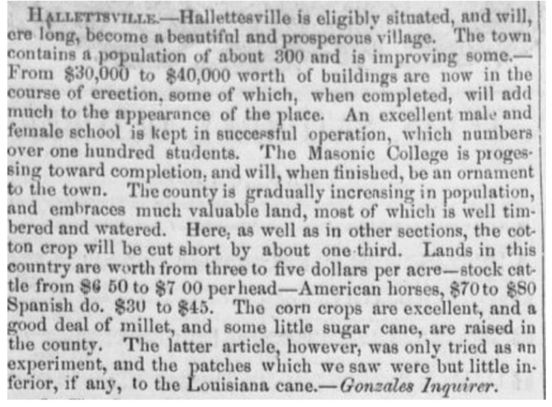ITEMS OF INTEREST
WHAT IS A VARA?

At the beginning of each Block Descriptor, there is a paragraph detailing that block. The measure of the block is given in varas.
Article from the Texas State Gazette, October, 28, 1854, heralding the qualities of Hallettsville.

a leaf from Hallettsville history
BY: MRS. M. J. BALLARD NEE HALLET HALLETTSVILLE HERALD DECEMBER 25, 1887
Hallettsville was laid out in the year 38 or 39 by Byrd Lockhart, one of the most competent surveyors of that early period, through a suggestion of his to Mrs. M. P. Hallet in honor of whom it is named.
Mrs. Hallet settled on the E. bank of the Lavaca, a short distance above Hallettsville, in 1833 where she remained, retreating with other settlers, upon the approach of Santa Anna's Army, and returning after his death, until her death in 18--.
Indians
The Indians, some of whom were friendly disposed, did not give the settler in this neighborhood any very great degree of annoyance, though, upon one occasion, finding two men, Nunnelly and Smothers engaged in cutting logs, somewhere in the vicinity of the present grave yard, for the purpose of putting up a house in the present town, attacked and killed them. The cattle, or rather milch-cows, by their peculiar behavior, were the most reliable indicators of the near approach of Indians, smelling, it is supposed, the smoked buck skin.
Please see the file below for the rest of the story.
A Leaf From Hallettsville (pdf)
DownloadGetting There
Getting There
In the early days reaching the Lavaca Settlement, or Hidesville or Ives Post Office, as Hallettsville was once called, was by way of blazed trails. Indians, wild cattle, horses, soldiers, explorers or settler wagons passing through the area along paths of least resistance created these sometimes-faint trails. Coming from the West people had to cross the Lavaca (La Baca) River at low water crossings.
Coming from the east, one such crossing near the town allowed travelers to enter just below what is now known as First Street, on the east bank of the Lavaca. This trail was the beginning of what later became the Hallettsville-Gonzales Road.
From the west as the trail neared the Lavaca River it became known as Gonzales Street. It was also later called the Gonzales-Cuero road and is now known as Fairwinds Ave. Originally the trail came to the river at what is now known as 4th St. and curved north along the west bank of the Lavaca River to the low water crossing.
In Gonzales County, the Commissioners Court Minutes of July, 1844, page 30, show that Commissioners were appointed “to view and lay off a public highway through what is known as the Labacca Settlement commencing at some ford on the Lavacca River to Gonzales County.” Thus was the road from Hallettsville westward laid out.
Now on the east side of town, from the records of Colorado County, there is mention of appointing Commissioners for a road from Columbus to Hidesville, one of the first names given to the settlement that became Hallettsville (Minutes of the Colorado County Court, Book 1, page 2, July 7, 1845).
Other roads/trails that entered Hallettsville were the Hallettsville-Schulenburg Road, Hallettsville-Austin Road on the north and the Hallettsville-Texana Road on the south.
Stay tuned, as more information on the roads will be added as more information is found. If you have any information to share about the trails and roads of Lavaca County please contact us.
Forever Divorced
The Rest of the Story, by Brenda Lincke Fisseler
Several years ago, I wrote a story on the first divorce filed in Lavaca County: Elenor Brown vs. Henry H. Brown. At the time, the story seemed to be pretty straightforward. However, recently while researching a completely unrelated topic, I found that there was much more to the Brown divorce than I knew. Other individuals played a huge role in the Brown divorce that was never mentioned in the court records. So now I am going to take this opportunity to, as Paul Harvey
would say, share with you the rest of the story ….
First, a brief recap of the Brown divorce.
Elenor Brown wanted out of her marriage. On July 12, 1849 she appeared before Spencer Townsend, Clerk of the District Court, in the Lavaca County courthouse in Petersburg and filed a petition for divorce from her husband Henry Brown.
In the petition Elenor stated that the Browns had been married on the 20th of July 1840 in Missouri and had immigrated to Lavaca County in 1847. In January of 1849, Elenor left her home and sought legal protection from her husband whom she claimed repeatedly subjected her to bodily harm and verbal abuse. On October 13, 1849 Elenor and Henry were granted a divorce and their joint property was to be divided equally between the two parties. It is not until over a year later, in October of 1850, that a settlement is reached and the court orders that deeds be made to the two parties according.
However, this story had some loose ends. Elenor last appears in Lavaca County in the 1850 Lavaca County census as a 30 old divorcee living in the county seat of Petersburg employed as a seamstress and sharing her home with 15 year old Mary Phelps. The property that Elenor was to receive from her divorce was never deeded and/or transferred to her. At the time, I had no clue as to what happened to Elenor, but by sheer luck, I do now.
Please see the file, below, for the rest of the story.
the rest of the story
Forever Divorced The Rest of the Story (pdf)
DownloadThe Times-Picayune, New Orleans, LA Tuesday, May 3, 1853

The above article references the Victoria Advocate's glowing description of Lavaca County and how it's growing.
Please see file, below, for larger, readable copy.
Larger copy of Article, above (pdf)
DownloadCreeks in Hallettsville
Creeks in Hallettsville (pdf)
DownloadHallettsville Block Party